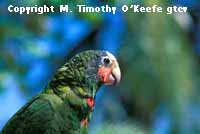Caribbean Islands Plants and Animals
|  | Caribbean flowers, trees and birds | ||||||
Caribbean Flora & FaunaThe Caribbean islands were born bare, without any animals or plants. Except for Trinidad, all of the West Indies are classified as oceanic islands, formed from fiery volcanic upheavals and other cataclysmic events.The islands accumulated their plant and animal populations in several ways. Some plants, such as mangroves, have seeds that float the ocean currents for months, make landfall and sprout. Other species spread by "rafting," where a seed or animal hitched a ride on a floating platform, something as small as a leaf, and traveled to an island. Many plants and animals were rafted to the Caribbean during the seasonal flooding of the Orinoco River. The mats of vegetation included rafts of bamboo, whose hollow spaces provided secure places for frogs and small lizards. Tree roots offered good cover for snakes and burrowing reptiles. Hurricanes also made rafting a regular and easy phenomenon. According
to the rafting theory, mammals and amphibians (which require
considerable fresh water to survive) should be scarce in
the Caribbean because they could not raft The most common mammals are rodents and bats. Amphibians consists of about three dozen species of frogs and toads in the region. Although
some islands do have a smattering of animal life, including deer, most
of what you'll see when walking even the thickest and healthiest
Caribbean rain forest are birds, lizards, and Which means no dangerous animals to look out for in general, though a few islands do have poisonous snakes. Birding . . . The best places Insects . . . Like them or hate them, bugs belong to the Caribbean. Manatees (Sea Cows) . . . Somehow these sausage-like animals were the basis for the mermaid legends. Caribbean Conservation Efforts . . . Which islands have worked hard to preserve their legacy. Caribbean Forests . . . They may all look the same--green--but Caribbean forests are amazingly varied. Trees & Vines . . . Bush Medicine 101 Trees and vines and what they're used for. Palms & Palm-Like Trees . . . Not everything that looks like a palm is, and vice-versa. Fruits & Vegetables .
. . Bush Medicine 102. They not only taste good, they're
usually good for you.
|
||||||||